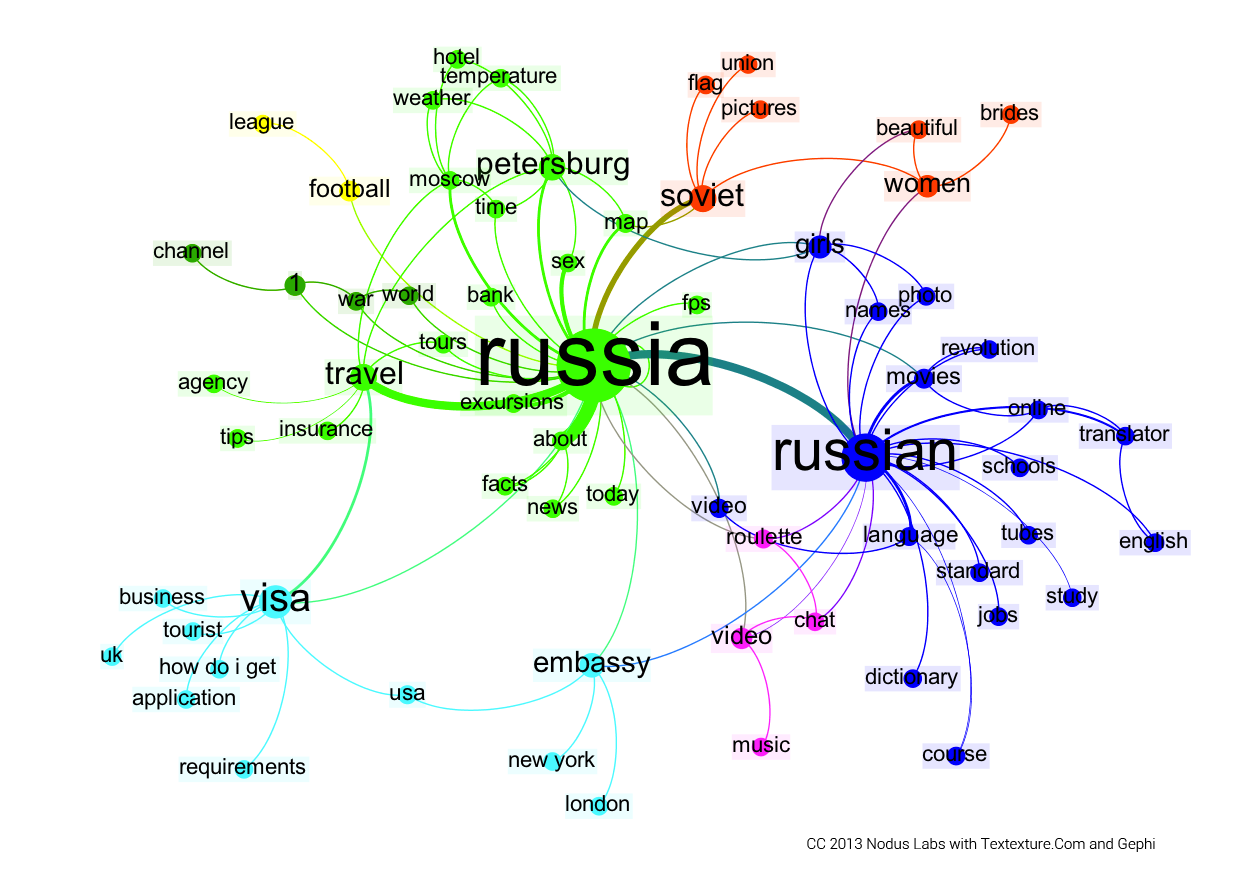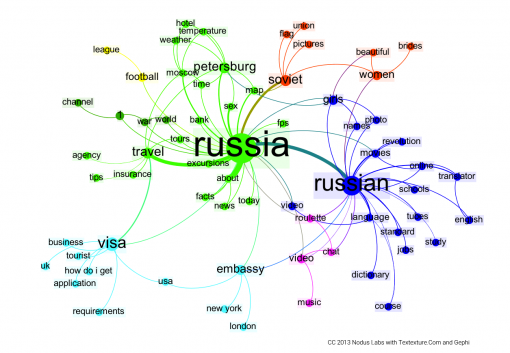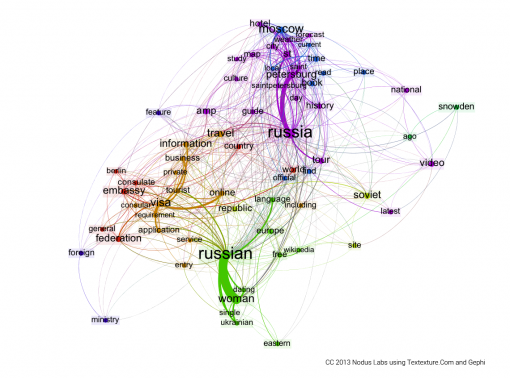Posted by Nodus Labs | August 3, 2013
Text Network Analysis for SEO

Way to Russia (http://www.waytorussia.net) is a popular online travel guide to Russia founded in 2001. They get the majority of their audience from Google search and thus were interested to see how our text network analysis methodology can help them create the content that would attract more readers, increase audience retention, and make sure that the readers are getting the information they need.
In order to tackle these questions we used text network analysis software developed by Nodus Labs for Textexture as well as Gephi visualization engine to identify the main keywords related to Russia as well as the contexts they’re used in. We then prepared some suggestions for Way to Russia editors as to what content should be presented within the same context to address the audience’s needs.
Customer: Way to Russia Guides (www.waytorussia.net)
Objective: Study what the audience that’s interested in Russia is searching for, what are the main topics of interests, and how this information can help build a more attractive and popular information resource for this audience.
What People Look For: Search Keywords Text Network for SEO
Our first step was to find out what people are searching for in relation to Russia. Way to Russia is a travel guide, so we tried to find the main topics of interest in relation to Russia in general and traveling to Russia specifically. We used Google Keywords Tool to identify the groups of keywords that often co-occur together in search and then used Google Trends to expand this list and to get a better insight about the dynamics of these terms.
The Figure 1 above shows the most prominent search terms related to Russia and their connections (the words are represented with nodes and their co-occurrence in search requests is represented with an edge). The words that co-occur more frequently in search next to each other are indicated with a relevant color. The nodes that have the highest betweenness centrality (or the ones that often connect different search contexts together and thus have a high influence in this graph) are bigger in the graph.
We can see that the terms “Russia” and “Russian” (obviously) are the most prominent ones. Then the network splits into several communities of search terms that tend to co-occur together:
1: russia - travel - petersburg - moscow
2: russian - girls - language - movies - translator
3: visa - embassy
4: soviet - women
5: football
6: war
This means that there’s a lot of interest to Russian travel and because of that there’s also interest towards the process of obtaining the Russian visa and finding Russian embassies to apply.
Petersburg seems to be slightly more popular in search requests than Moscow.
When people are searching the facts about the cities they are generally interested in weather, temperature and hotels.
Another important interests are the “Russian Language“, “Movies” and “Videos“.
The search terms that are frequently used with “Russia” are “facts” and “news“.
The next important cluster of related search terms are “Soviet” and “Women“, the term “Girls” is also located very close to those two.
Finally, there are two other smaller clusters related to “football” and “world war“.
What People Find: Google Search Results Text Network
Now that we’ve identified what are the most prominent search terms related to Russia, let’s see what search results are shown when people actually use those search terms in search engines.
We processed search queries for the 10 most popular search terms like “Russia”, “Russian”, “Russian Visa”, “Russian Embassy”, “Russian Travel”, “Soviet Russia”, “Russian Women”, “Russian Girls”, “Russia Petersburg”, and “Russia Moscow”. We took the results from the first 3 pages of Google search, including the found pages’ titles and excerpts provided by Google. We then processed this text data (once per every search term) in Textexture to obtain a text network visualization of the data.
The resulting graph shows what results people actually see in Google when they search for those terms online:
As can be seen from the Figure 2 above, the main topical clusters are nearly the same as what people are searching for. This indicates the fact that Google is not only good in delivering the pages that contain the information that people search for, but that it also takes into account the context where this information appears. The search engine, thus, makes sure that those pages that have the context similar to the search terms co-occurrence will rank higher in search results.
Specifically, the main contexts inside the search results related to Russia are:
1: russia - petersburg - guide - tour - weather - video (+1a: moscow)
2: visa - information - travel (+2a: consulate - embassy)
3: russian - woman - language
4: soviet
Those are quite similar to the contexts we identified in the first section (what people look for). However, we can also see that the topics (or co-occurring words) presented in search results do not fully respond to the interests of the people who do the search queries.
Specifically, the term “movies” is not present in the “Russia – video” community second graph. Also, the words “chat”, “roulette” are underrepresented comparing to search demand. The theme of language is not fully explored, there’s no reference to “translator” and “english” in search results even though people do look for it. Also, all references to “women” and “girls” in the search results are often linked to “dating”, while originally people also look for just “photos”, “beautiful”, “names” in relation to those terms.
Finally, the “visa” / “consulate” search results provide somewhat of a general response, not taking into account that most people want to find an embassy of Russia in London and in New York.
In general we can see that in order to serve user queries more precisely and stand out among competition, the website should not only provide the answers in the context they are expected in, but to also make sure that this context is thoroughly explored in relation to users’ interests.
Recommendations for Way to Russia:
The following recommendations were presented to WayToRussia.Net at this stage. Note, that we did not yet analyse the website itself in order to make another reiteration to this list once we get a better idea of the site’s current structure. The recommendations below is a general list of recommendations to any website about Russia that wants to be visible in Google’s search results
1) Organize content in several meaning blocks:
a) Travel Facts about Russia
b) Russian Tours
c) Petersburg and Moscow Guides (particularly focus on weather, temperature, time, hotel listings and reservations and maps)
d) Video and Films from Russia (links to interesting YouTube channels, listings of Russian films)
e) Russian Language (including translator to English, dictionary and a study guide)
f) Russian Visa (focus on applications and requirements, addresses of embassies in London, New York, USA)
g) Russian History (particular emphasis on the Soviet times and 1st and 2nd World War)
h) Russian People (particular emphasis on women, girls, photos, names, etc.)
2) To stand out among competition it’s recommended to give a bit more focus to culture and history. For example, when writing about video make a section about Russian movies. When writing about Russian people and women, not only focus on dating aspect, but also write about various stereotypes, post photos, write about girl names, connect this narrative with the other topic on Soviet history (like this the information will respond more to the users’ needs).
3) Focus on delivering practical answers to what people are searching for. For instance, the terms “embassy” and “consulate” should appear in the context where the Russian embassy’s addresses in London and New York are listed as that’s what people are searching for.
Site Analysis: Text Network of Content
Now that we know what people search for in relation to Russia and what they get in their search results, it’s time to analyse whether our customer WayToRussia.Net delivers the content required by users.
We use Google Webmaster Tools -> Search Queries section to see which search terms most clicks to the site come from. This will give an idea of what contexts the website appears in at the moment in Google’s search results.
The most popular terms relate to the russian food, russian language (mostly swearwords), russian visa, immigration, trains from moscow to petersburg, airport information, teaching English in Russia.
The most popular pages on the site (data from Google Analytics) are also very similar to the list above (obviously, as most of the traffic comes from Google search).
It’s important to note at this point that there’s discrepancy between what people in general tend to search for in relation to Russia and what WayToRussia.Net provides back. However, this is not because the website doesn’t have the content. For example, there are sections on Soviet History and the 1st and 2nd World War in What is Russia part of the website.
There is also a full Russian language guide (not only the swearwords).
Moscow and St. Petersburg guides are very thorough on the site, but they don’t appear as often in Google search results.
There’s also a section on Russian women and about Russian people in general, but, again, it’s not the most often visited one.
The reason for that discrepancy is that Google ranks higher the pages that have both internal and external URLs linking to them. Webmaster Analysis Tool shows that the most popular and most frequently found pages are the ones that are also linked to the most.
Also, there’s a whole topic that’s underexplored on WayToRussia.Net and it’s that of the video and movies – quite a popular search query in general.
So, our additional recommendations for Way to Russia based on the website’s analysis would be:
4) Link more thoroughly across the website to sections like Russian language, Soviet history and Russian women, Moscow and St. Petersburg guides (preferably from the pages that are contextually related).
5) Establish external links to those sections from other sites, for instance from Blogspot blogs (as those already link quite extensively to the site) as well as the different forums.
6) Add a section on Russian movies and video, showcasing the most interesting visual material related to Russia. Make sure it’s linked to from other sites and internally.
Polysingularity of Content
Our objective in doing this study was not only that of increasing the site’s popularity. The people at WayToRussia.Net realize that an important aspect of an information resource is to carry a certain perspective on the subject (in this case, Russian travel), and inevitably this will mould people’s experience and opinions. The more original and fresh this perspective is, the more interesting and special the website will appear to the readers. This, in turn, will improve audience retention and provide a possibility to have an effect on the general narrative about the country.
We saw in Figure 1 what people expect when they search for Russia on Google: it’s tours, travel, Moscow, St Petersburg, Russian visas and embassies, YouTube videos, movies, women, girls, sex, language and a bit of Soviet and WW1/WW2 history. This is the general field of interests related to Russia and is being served quite well. However, if one was to make information resource that only caters to those interests, they would be helping construct a certain rigid image of the country that’s quite limited in its scope.
For instance, there’s many more interesting destinations to travel in Russia than Moscow and St. Petersburg, such as Trans-Siberian, small provincial towns in central parts, beautiful vast natural resorts.
There’s also amazing literature, some of which came out during the 20th and 21st centuries and is not widely known to people from other countries. Probably those who are interested in movies and language could also be interested in finding a few good Russian books.
Finally, if the city guides only focused on weather and hotels they would be catering to immediate needs. Those are important, but there’s much more to the Russian cities than finding a place to stay and making sure you don’t die of the Russian winter. For instance, there is impressive nightlife, many interesting local and former USSR cuisine restaurants, tourist sights that are off-the-beaten track and other possibilities for entertainment that can also be educative in some ways.
Therefore, our final recommendation to Way To Russia would be to
7] Make sure those more obscure topics that are already present on the site, would be made more prominent to the readers. This should be done through extensive internal and external linking to those pages.
8] Relevant sections, which are less known and popular should be attached to the already popular ones. This could be done through finding topical coherence (e.g. movies – literature, moscow – clubs, petersburg – sights, russian language – translator). This would increase the diversity of available content and also expand readers’ idea of what Russia is about.
Polysingularity is the condition where there are multiple centers of activity, which are constantly reiterated. The old ones dissolve, the new ones emerge. The dynamics within those centers of activity also ensures that there’s a constant change and development within. Polysingularity of content ensures that information that is delivered to end users does not only cater to their existing tastes and knowledge, but also proposes a new way of looking at things and different perspectives.



